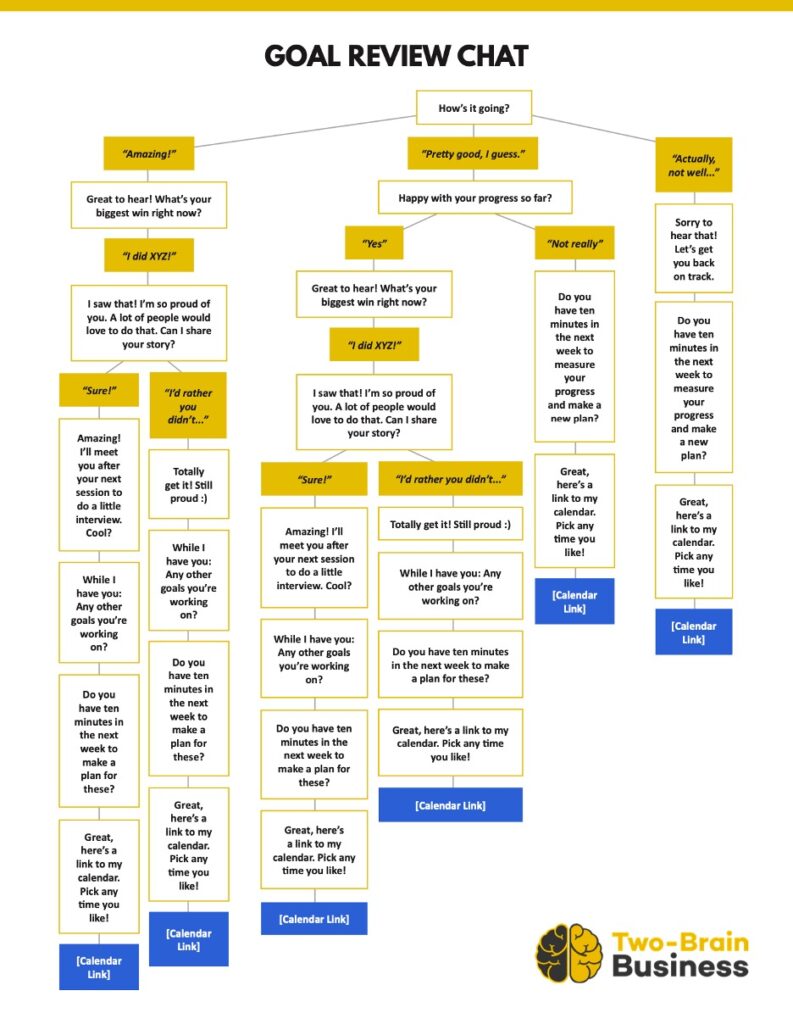Every client in your gym wants to achieve something.
Some have general goals, such as feeling better or improving their fitness. Some have specific goals, such as losing 20 lb. or finishing a 100-km bike ride faster than last year.
Two-Brain gyms follow the Prescriptive Model, which starts by helping the client get clarity on their exact goals. This is the first step to getting results for the client.
You should ask all new clients about their goals as part of your intake process. But even if you haven’t asked current clients about goals before, you can start doing Goal Review Sessions in your gym now—and you should.
Getting clear on clients’ goals will:
- Improve your retention. A clear goal and a plan to reach it will keep each client around longer.
- Improve your average revenue per member (ARM). Some clients are buying the wrong service for their goals.
- Fulfill you as a coach because results in your gym will become measurable. When you say “we make people more fit!” that won’t just be a slogan or a guess.
If you’re using the Prescriptive Model in your gym, booking Goal Review Sessions is easy. You simply text a client “it’s time for your goal review!” and then attach a booking link. But if you’re just starting with goal reviews, you’ll need to explain their value.
Here’s a script to help you book goal reviews by chat:

Goal Reviews: Step by Step
Here’s how to do a goal review, step by step:
1. Measure the thing the client cares about. If it’s body composition, measure their body composition. If they want to make their bike go faster, have them bring in their Garmin data (or just look at their rides on Strava). We use an InBody scan with about 70 percent of our clients.
2. Ask, “Are you completely happy with your results so far?”
3. If they say “yes!” then ask to share their story. Pull out your camera and interview them.
4. If they say “kinda,” they’re asking you how to get results faster. Tell them (it probably means coming more often, adding nutrition coaching or doing more focused training 1:1).
5. If they say “no, I’m not happy with my results,” it means they’re buying the wrong thing. Tell them what you’d do in their shoes. Often, this happens when clients sign up for your lowest-priced option when they join and they need more from you to make swifter progress.

Two things to remember:
1. This is not an upsell. Though about 30 percent of people wind up paying more after a Goal Review Session, it’s because they were buying the wrong thing in the first place. Goals change, and as you build trust, clients might want more from you. Or maybe they’re in your group class and need one-on-one training. Sometimes, a goal review reveals that a client should downgrade their membership. You can build trust and often prevent a hold request or cancellation if you say, “This is your busiest time of year. I recommend we maintain your fitness for the next few months instead of pushing really hard. Let’s do two workouts per week and then meet again in two months. Sound good?” The key is getting in front of problems and opportunities and telling a client what will help them best.
2. Many people who do one-on-one sessions in any gym don’t need to do personal training. They want to do personal training. They’re not doing rehab; they want a flexible schedule or privacy, or they want to make progress as quickly as possible with a customized program. Even though you might love training in a group, remember that you’re not the same as your average client. They might want more attention, more privacy, more schedule flexibility or all three.
In your annual plan, goal reviews should be scheduled two to four times a year. Because both goals and preferences change over time, you can get ahead of problems—and increase speed to progress—through regular Goal Review Sessions.
If you don’t have goal reviews on your calendar, you can start using them right now to prevent or fix the “summer slump” that affects many gyms. Some of your clients are in danger of fading away to the patio, and if you find out about their goals and recommend a plan, you’ll keep them on track this summer. Other clients will jump at the chance for more attention, and that ARM bump can help a lot in a season that’s traditionally rough on gym owners.
Goal reviews are all about aligning client progress with client preferences. Tell them what to do and offer to help in the way they want it.
That’s real fitness leadership.

